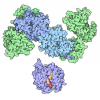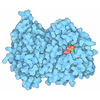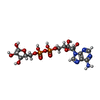+ Open data
Open data
- Basic information
Basic information
| Entry | Database: PDB / ID: 6pus | ||||||
|---|---|---|---|---|---|---|---|
| Title | Human TRPM2 bound to ADPR and calcium | ||||||
 Components Components | Transient receptor potential cation channel subfamily M member 2 | ||||||
 Keywords Keywords | TRANSPORT PROTEIN / TRPM2 channel / ADPR / calcium | ||||||
| Function / homology |  Function and homology information Function and homology informationcellular response to purine-containing compound / mono-ADP-D-ribose binding / manganese ion transmembrane transporter activity / zinc ion transmembrane transport / dendritic cell differentiation / response to purine-containing compound / regulation of filopodium assembly / ligand-gated calcium channel activity / cellular response to temperature stimulus / TRP channels ...cellular response to purine-containing compound / mono-ADP-D-ribose binding / manganese ion transmembrane transporter activity / zinc ion transmembrane transport / dendritic cell differentiation / response to purine-containing compound / regulation of filopodium assembly / ligand-gated calcium channel activity / cellular response to temperature stimulus / TRP channels / dendritic cell chemotaxis / sodium channel activity / calcium ion transmembrane import into cytosol / response to hydroperoxide / temperature homeostasis / calcium ion import across plasma membrane / intracellularly gated calcium channel activity / tertiary granule membrane / ficolin-1-rich granule membrane / specific granule membrane / monoatomic cation channel activity / release of sequestered calcium ion into cytosol / cellular response to calcium ion / cell projection / regulation of actin cytoskeleton organization / calcium ion transmembrane transport / cytoplasmic vesicle membrane / calcium channel activity / cellular response to hydrogen peroxide / calcium ion transport / response to heat / perikaryon / protein homotetramerization / lysosome / lysosomal membrane / calcium ion binding / Neutrophil degranulation / plasma membrane Similarity search - Function | ||||||
| Biological species |  Homo sapiens (human) Homo sapiens (human) | ||||||
| Method | ELECTRON MICROSCOPY / single particle reconstruction / cryo EM / Resolution: 3.7 Å | ||||||
 Authors Authors | Du, J. / Lu, W. / Huang, Y. | ||||||
| Funding support |  United States, 1items United States, 1items
| ||||||
 Citation Citation |  Journal: Elife / Year: 2019 Journal: Elife / Year: 2019Title: Ligand recognition and gating mechanism through three ligand-binding sites of human TRPM2 channel. Authors: Yihe Huang / Becca Roth / Wei Lü / Juan Du /  Abstract: TRPM2 is critically involved in diverse physiological processes including core temperature sensing, apoptosis, and immune response. TRPM2's activation by Ca and ADP ribose (ADPR), an NAD-metabolite ...TRPM2 is critically involved in diverse physiological processes including core temperature sensing, apoptosis, and immune response. TRPM2's activation by Ca and ADP ribose (ADPR), an NAD-metabolite produced under oxidative stress and neurodegenerative conditions, suggests a role in neurological disorders. We provide a central concept between triple-site ligand binding and the channel gating of human TRPM2. We show consecutive structural rearrangements and channel activation of TRPM2 induced by binding of ADPR in two indispensable locations, and the binding of Ca in the transmembrane domain. The 8-Br-cADPR-an antagonist of cADPR-binds only to the MHR1/2 domain and inhibits TRPM2 by stabilizing the channel in an apo-like conformation. We conclude that MHR1/2 acts as a orthostatic ligand-binding site for TRPM2. The NUDT9-H domain binds to a second ADPR to assist channel activation in vertebrates, but not necessary in invertebrates. Our work provides insights into the gating mechanism of human TRPM2 and its pharmacology. | ||||||
| History |
|
- Structure visualization
Structure visualization
| Movie |
 Movie viewer Movie viewer |
|---|---|
| Structure viewer | Molecule:  Molmil Molmil Jmol/JSmol Jmol/JSmol |
- Downloads & links
Downloads & links
- Download
Download
| PDBx/mmCIF format |  6pus.cif.gz 6pus.cif.gz | 881.3 KB | Display |  PDBx/mmCIF format PDBx/mmCIF format |
|---|---|---|---|---|
| PDB format |  pdb6pus.ent.gz pdb6pus.ent.gz | 683.3 KB | Display |  PDB format PDB format |
| PDBx/mmJSON format |  6pus.json.gz 6pus.json.gz | Tree view |  PDBx/mmJSON format PDBx/mmJSON format | |
| Others |  Other downloads Other downloads |
-Validation report
| Summary document |  6pus_validation.pdf.gz 6pus_validation.pdf.gz | 1.3 MB | Display |  wwPDB validaton report wwPDB validaton report |
|---|---|---|---|---|
| Full document |  6pus_full_validation.pdf.gz 6pus_full_validation.pdf.gz | 1.4 MB | Display | |
| Data in XML |  6pus_validation.xml.gz 6pus_validation.xml.gz | 128 KB | Display | |
| Data in CIF |  6pus_validation.cif.gz 6pus_validation.cif.gz | 196.9 KB | Display | |
| Arichive directory |  https://data.pdbj.org/pub/pdb/validation_reports/pu/6pus https://data.pdbj.org/pub/pdb/validation_reports/pu/6pus ftp://data.pdbj.org/pub/pdb/validation_reports/pu/6pus ftp://data.pdbj.org/pub/pdb/validation_reports/pu/6pus | HTTPS FTP |
-Related structure data
| Related structure data |  20480MC  6puoC  6purC  6puuC C: citing same article ( M: map data used to model this data |
|---|---|
| Similar structure data |
- Links
Links
- Assembly
Assembly
| Deposited unit | 
|
|---|---|
| 1 |
|
- Components
Components
| #1: Protein | Mass: 172280.062 Da / Num. of mol.: 4 Source method: isolated from a genetically manipulated source Source: (gene. exp.)  Homo sapiens (human) / Gene: TRPM2, EREG1, KNP3, LTRPC2, TRPC7 / Production host: Homo sapiens (human) / Gene: TRPM2, EREG1, KNP3, LTRPC2, TRPC7 / Production host:  Homo sapiens (human) / References: UniProt: O94759 Homo sapiens (human) / References: UniProt: O94759#2: Chemical | ChemComp-APR / #3: Chemical | ChemComp-CA / Has ligand of interest | N | |
|---|
-Experimental details
-Experiment
| Experiment | Method: ELECTRON MICROSCOPY |
|---|---|
| EM experiment | Aggregation state: PARTICLE / 3D reconstruction method: single particle reconstruction |
- Sample preparation
Sample preparation
| Component | Name: human TRPM2 / Type: COMPLEX / Entity ID: #1 / Source: RECOMBINANT |
|---|---|
| Source (natural) | Organism:  Homo sapiens (human) Homo sapiens (human) |
| Source (recombinant) | Organism:  Homo sapiens (human) Homo sapiens (human) |
| Buffer solution | pH: 8 |
| Specimen | Embedding applied: NO / Shadowing applied: NO / Staining applied: NO / Vitrification applied: YES |
| Specimen support | Details: unspecified |
| Vitrification | Cryogen name: ETHANE |
- Electron microscopy imaging
Electron microscopy imaging
| Experimental equipment |  Model: Titan Krios / Image courtesy: FEI Company |
|---|---|
| Microscopy | Model: FEI TITAN KRIOS |
| Electron gun | Electron source:  FIELD EMISSION GUN / Accelerating voltage: 300 kV / Illumination mode: FLOOD BEAM FIELD EMISSION GUN / Accelerating voltage: 300 kV / Illumination mode: FLOOD BEAM |
| Electron lens | Mode: BRIGHT FIELD / Nominal defocus max: 2500 nm / Nominal defocus min: 1000 nm / Cs: 2.7 mm / C2 aperture diameter: 100 µm |
| Specimen holder | Cryogen: NITROGEN |
| Image recording | Average exposure time: 8 sec. / Electron dose: 6.8 e/Å2 / Detector mode: SUPER-RESOLUTION / Film or detector model: GATAN K2 SUMMIT (4k x 4k) |
| Image scans | Movie frames/image: 40 / Used frames/image: 1-40 |
- Processing
Processing
| EM software |
| ||||||||||||||||||||||||||||||||
|---|---|---|---|---|---|---|---|---|---|---|---|---|---|---|---|---|---|---|---|---|---|---|---|---|---|---|---|---|---|---|---|---|---|
| CTF correction | Type: PHASE FLIPPING AND AMPLITUDE CORRECTION | ||||||||||||||||||||||||||||||||
| 3D reconstruction | Resolution: 3.7 Å / Resolution method: FSC 0.143 CUT-OFF / Num. of particles: 287184 / Symmetry type: POINT | ||||||||||||||||||||||||||||||||
| Atomic model building | Protocol: AB INITIO MODEL / Space: REAL |
 Movie
Movie Controller
Controller






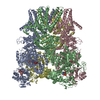
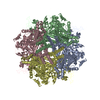

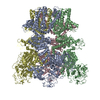
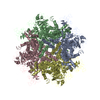


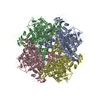
 PDBj
PDBj
